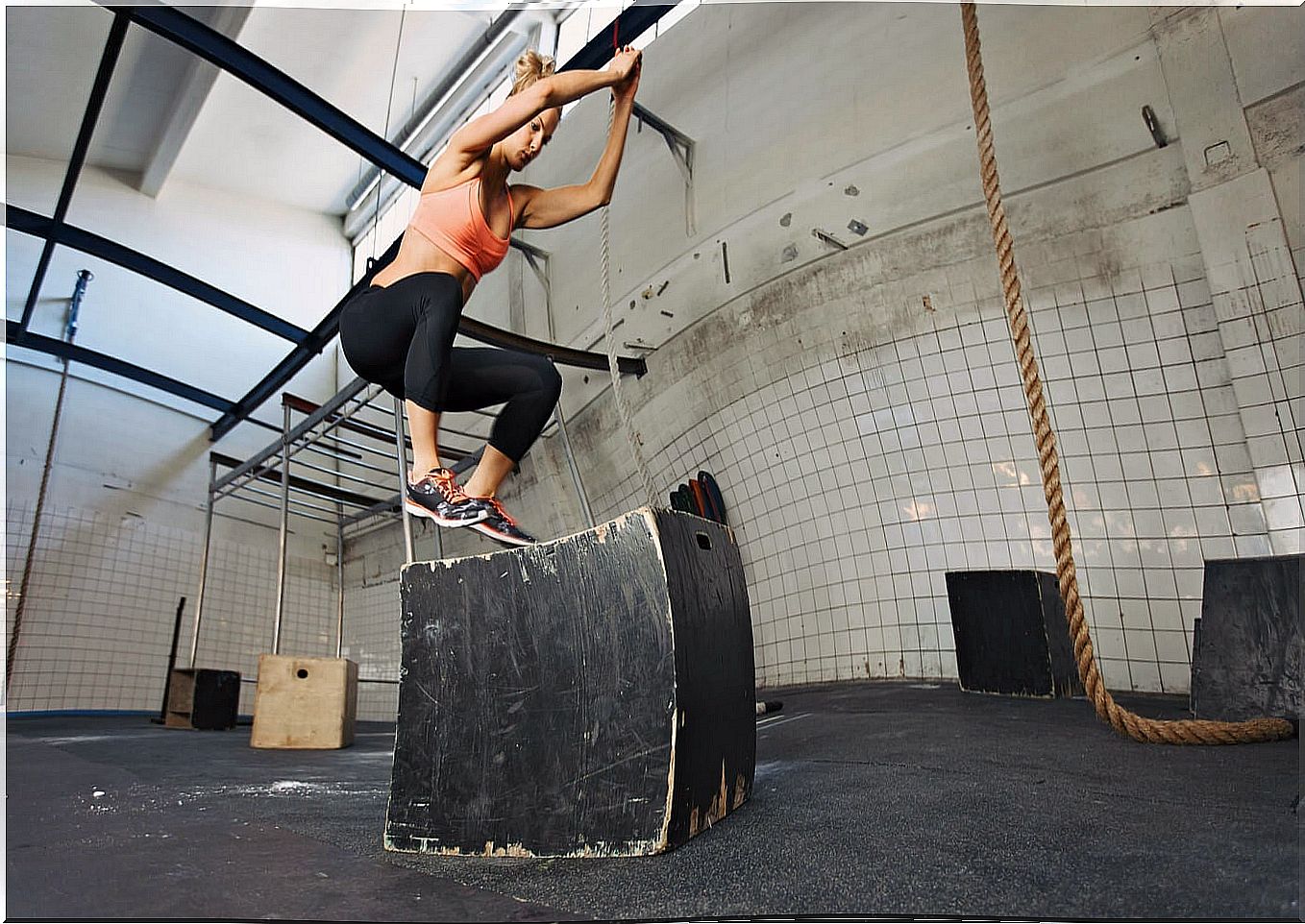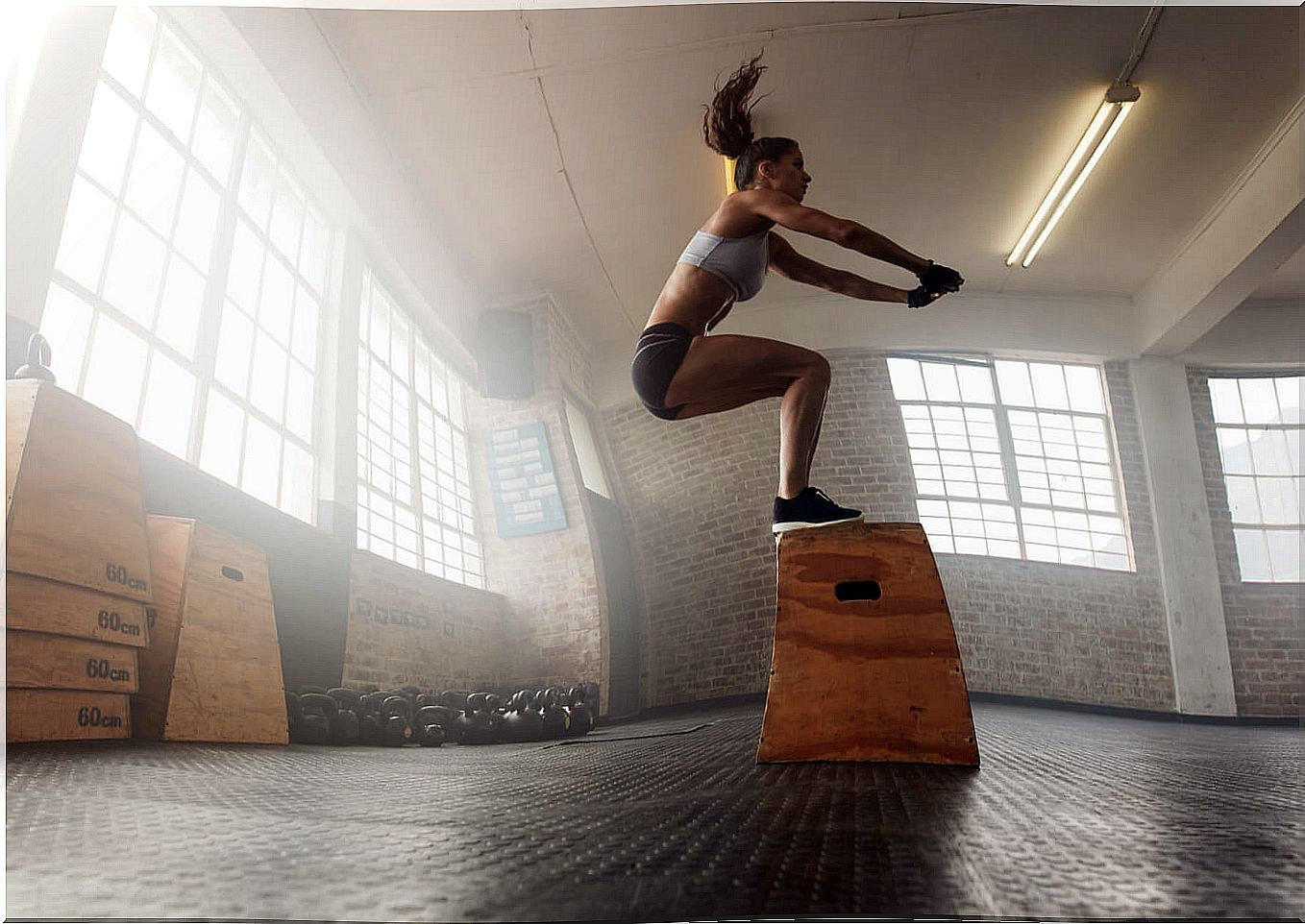Box Jumps: What Is This Exercise For?
The Box Jumps or leaps to the drawer are a type of full – body plyometric exercise. In fact, this exercise is also known as the “plyometric jump.” This exercise, very common in crossfit training , unifies the benefits of a cardiovascular and strength training in a single movement.
By including Box Jumps in the training routine, explosive power is developed in the lower body. In addition, it is an exercise considered very good to increase the height of the vertical jump.
If you are physically fit, including box jumps in your training will help you increase speed and strength. This is useful for people who want to improve their performance in all kinds of sports. On the other hand, this exercise allows you to work the muscles from head to toe, as well as agility, balance and coordination.
How to do box jumps: basic exercise

Jumping onto a raised platform seems very simple. And it is. But it’s not just about climbing, it’s about getting it right. You can climb into the box by jumping anyway and you will achieve an effective movement – after all, you are on top, right? -.
However, it is about performing an efficient movement, which in this case means maximizing the effect while minimizing the risk of injury. Executing the box jumps correctly and efficiently involves following the following steps:
- Stand in front of the drawer, a short stride away, shoulder-width apart.
- Bend your knees slightly. Lower your hips slightly (up to a quarter squat) to gain momentum as you bring your arms back. Do this by activating the core muscles.
- Use momentum to propel yourself upward as you jump into the box, assisting you with the swing of your arms.
- Land gently on both feet with a slight bend in the knees, without dropping the hips too low (it should be slightly above the knees). The arms are stretched forward to balance.
- Take a step back and down, and repeat.
Most common mistakes
Box jumps are only beneficial when performed with correct technique and efficiently. In this sense, in addition to paying attention to the correct way to perform the exercise, it is important to take into account the following:
- Don’t use a box that is too tall. If the box is too high, you may not be able to climb up, which could lead to injury. And if you do, the landing will force you to squat very deep.
- Don’t get off the box by jumping backwards. In this exercise, the jump is made to go up, not to go down. Although your body can efficiently absorb the landing of a box jump, the same is not the case with the jump back. If you do so, you run the risk of injury.
- Be careful with the landing. After the jump up the knees should be aligned with the ankles, not outwards or inwards. Also, you must be careful with the hips; It should be slightly higher than the knees.
- Always get off the box with the same leg. You should alternate the leg you come down from the drawer with so as not to overload one over the other. If you have trouble remembering which one you came down with in the previous jump, do a series going down with one and another going down with the opposite one.
- Not heating properly. Box jumps are an intense exercise that requires a good warm-up. If you have not warmed up properly, the risk of injury is very high, both from the force required by the push and from the impact of the landing.
Box hopping variations

Once you have mastered the box jumps you can incorporate more demanding variations. Some of these variations are as follows:
- With one leg. You can take off and land with just one leg or, if this is too much, take off with one and land with two.
- Twist jump. Stand with the box aside. This position implies the need to do a rotation to jump and land on both feet.
- Jump in two steps. Stand one meter from the box. Take a first jump forward and a second jump up. You can increase the challenge by getting further and further away, which will involve a longer first jump.
- Burpee with jump. To increase the challenge, do a burpee before doing the jump.
- Seated jump. To develop more explosiveness, start from a seated position so you don’t have the benefit of the initial push. Start by sitting on a bench the same height as the box before using a taller one.
- Weighted jump. Use weight to increase the difficulty of the basic exercise. You can use weighted items (vests, wristbands, etc.) or a pair of light dumbbells.
Why Include Box Jumps in Workouts
The biggest benefit of box jumps is that they enhance the reaction of fast-twitch muscle fibers throughout the body. This is because this type of jump requires the leg and core muscles to contract very quickly in order to generate maximum force with each jump.
Plyometric activity occurs in the landing phase. The benefit here is obtained by reducing the risk of injury and increasing the ability to make sudden stops in other activities. The higher and more explosive you jump, the more muscle tissue is activated.
On the other hand, box jumps are excellent for completing quadriceps training, as they activate some fast-twitch muscle fibers that are generally not worked during other types of common exercises, presses or squats. Additionally, the landing phase also requires a tremendous amount of quadriceps strength.
Finally, note that the Jumps Box are also an excellent exercise to incorporate into your fat loss workout because they are very demanding for the metabolic system and, therefore, they burn a lot of energy.
Final comments
The Box Jumps help train all muscle groups in the lower part of the body, including the buttocks, hamstrings, quadriceps and calves, they have to work together and coordinated to improve power and strength.
However, beyond the lower body, box jumps also require a lot of core engagement and a controlled swinging motion of the arms, which is why box jumps are a full-body exercise.
Keep in mind that this is not an exercise for everyone. In addition to having good technique, you also have to be in excellent physical shape. For this reason, it is more than advisable to start with low boxes and only when enough strength and power have been developed to do the jumps correctly.








